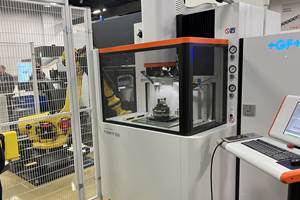Passivation of Stainless Steel Parts: The Recipe for Success
Passivation—the process for making stainless steel parts more corrosion-resistant—is affected by how well the part is cleaned. It’s also affected by the choice of acid. Nitric or citric?
Share







Hwacheon Machinery America, Inc.
Featured Content
View More



Takumi USA
Featured Content
View More
ECi Software Solutions, Inc.
Featured Content
View MoreThe procedure known as “passivation” actually represents just an improvement and enhancement to a process that occurs naturally on most stainless steels. This process involves the passive, chemically inert surface layer or film that forms when the stainless steel is exposed to an oxygen environment. The formation of this natural passive film can be affected or impaired by contaminants (dirt, oils, grease, compounds, scale) and by the presence of free iron on the part surface. Therefore, a dedicated shop floor passivation process is designed to remove these contaminants to produce clean and corrosion-resistant stainless steel parts. This step can be critical for the safety and performance of stainless steel parts and devices, and it’s often required in the aerospace and medical industries, among others.
Passivation Standards
For many types of parts and industries, including many military specifications, ASTM standards A380 and A967 (www.astm.org) provide the guidelines for good passivation practice. These standards detail acceptable methods and/or recipes for passivating stainless steel and provide tests for measuring passivation success. AMS2700C (www.sae.org) establishes acceptable passivation methods and/or recipes, practices, and test protocols for aerospace, and supersedes AMS-QQ-P-35 (canceled in 2005 although sometimes still referenced by purchasers).
The Passivation Process
In all cases, cleaning is the first step in the passivation process, though this cleaning might take place in a separate process line or cell. The type of cleaning required depends on the contaminant(s), the soil loading, the degree of cleanliness required and the part geometry. Cleaning to remove deposited contaminants such as dirt and grease might involve swabbing, vapor degreasing or spray, or it might involve immersion with or without ultrasonics and/or agitation. The cleaning chemistry or detergent should be appropriate for the type of soil(s) to be removed and should be handled in accordance with safety and environmental regulations. If descaling (removal of heavy oxide films from heat treating or welding, or heat tint) is needed, then pickling or electropolishing followed by thorough rinsing may be required, and subsequent passivation with nitric or citric acid may not be indicated (refer to ASTM A380 and B254).
In a multiple-station immersion passivation line, the process often begins with one or more cleaning tanks that are equipped with ultrasonics and filtration, as well as possibly agitation or indexed rotation (if part geometry or soil loading suggests this to be advantageous), and a water-based cleaning chemistry or detergent. Parts should be presented in baskets, fixtures, racks, or indexing equipment in such a way as to optimize solution contact with all critical surfaces in each process step, even in the case of complicated part geometries.
The cleaning station is followed immediately by one or more rinse stations which again may be equipped with mechanical actions such as ultrasonics, agitation, indexing, and/or spray off to facilitate good rinsing. Counter-flow rinsing techniques and automatic make- up devices maximize efficient water use, conservation, and consistency.
Nitric Acid or Citric Acid?
The acid stage of the passivation process follows next. This step involves controlled contact between the cleaned stainless steel parts and the diluted nitric or citric acid according to one of several possible recipes defined in specifications such as ASTM A967 and AMS2700C. The purpose of this step is to remove free iron and foreign contaminants which may remain after the successful completion of the previous cleaning and rinsing steps. Successful removal of free iron and exogenous material facilitates the formation of the natural passive film or layer on stainless steel, enhancing its corrosion resistance.
When possible, the passivation step involves full immersion of the part(s) in a passivation bath. The bath should be sized to allow for solution movement around and throughout the load, which can be further enhanced with recirculation and/or ultrasonics. All of the equipment associated with the passivation step should be compatible with the selected acid.
Concentration of the acid, temperature of the bath, and contact time are all proportionate in the passivation recipes and are critical to the successful implementation of the specification(s). These process parameters can be monitored either manually or automatically in systems that are so equipped, and long-term data storage is available.
Nitric acid has been the traditional acid of choice for this passivation step, although both ASTM A967 and AMS2700C allow for the use of citric acid. In recent years, citric acid has been gaining ground because it is friendlier than nitric acid in terms of safety and environmental considerations. Another exciting aspect of citric acid is that its cycle times can be shorter. Citric acid passivation is considered acceptable as long as it meets the stipulated specification and the purchaser’s requirements, including successful passivation test results. Some shops now are expanding their capabilities by setting up passivation lines that have both nitric and citric passivation tanks followed by dedicated rinses.
Regardless of which acid is designated, chemistry-appropriate equipment (for personal protection and the safeguarding of the process) should be used during the passivation, and handling, storage and disposal of the selected acid must be in accordance with federal, state and local regulations.
Thorough Rinsing
The passivation bath is followed immediately by one or more rinses which may be spray or immersion, or a combination, depending on the specification(s), part geometry, and water conservation philosophy. Again, more rinses set up to counter-flow provide superior rinsing and, at the same time, conservation. Sometimes a neutralization step (such as 5% sodium hydroxide) or a post-treatment step (typically sodium dichromate) may also be indicated, again followed immediately by rinsing. The final rinse should be fed with “clean water,” with deionized (DI) or reverse osmosis (RO) water being good choices to prevent spotting. Rinsed parts are immediately dried. In scenarios where particle counts are critical, the dryer may be outfitted with a high efficiency particulate air filter (HEPA), and/or the whole process may be conducted in an appropriate-class clean room setting.
Passivation Equipment
The optimum equipment for batch immersion passivation is a manual or automated process line consisting of a continuous series of tanks. Lot volumes and throughput requirements influence tank size as well as the number of process stations recommended to meet production goals. The number of required processes also impacts the number of process stations. A continuous automated line, for example, may feature cleaning, pickling, and passivating in one line, each with dedicated rinses, with PLC controlled programs for each process and parallel or random operation as desired. A number of safeties including push-pull exhaust, enclosures, light curtain(s), and/or secondary containment are also available, as well as statistical process control, bar coding, and/or data management.
Passivation Success
The success of the passivation process is typically determined through inspection and/or testing. Upon completion of passivating, rinsing and drying, parts should show no surface defects such as pitting, etching or frosting, and no staining indicative of the possible presence of free iron.* Parts may be subject to post-passivation tests for free iron as required by the stipulated specification(s) or by the purchaser. These tests can include water immersion, high humidity, salt spray or copper sulfate, among others, performed in accordance with ASTM A967 and/or AMS2700C.
About the authors: Miraclean designs and manufactures citric and nitric passivation lines, among other cleaning and finishing systems. Brian Sutton is technical director of Miraclean and Cheryl Larkin is northeast territory manager.
*AMS2700C, 2008-11, 3.2.2 and ASTM A380-06, 7.2.1, 7.2.3
Related Content
GF Machining Solutions Plans to Open New Medical Manufacturing Facility
The new center will provide medicamanufacturers with applications support and production technologies, including precision milling, EDM, laser texturing, micromachining and automation
Read MoreArch Cutting Tools Acquires Custom Carbide Cutter Inc.
The acquisition adds Custom Carbide Cutter’s experience with specialty carbide micro tools and high-performance burrs to Arch Cutting Tool’s portfolio.
Read MoreEDM, Laser Micromachining and More at GF Medical Demo Center
At GF’s Medical Center of Competence, the company shows off EDM and laser features that could make a large impact on medical manufacturing — and elsewhere.
Read MoreSupercritical Success for Medical Machining
High-pressure carbon dioxide coolant can dramatically improve the production rate of titanium parts while leaving no residue — an excellent fit for medical machining.
Read MoreRead Next
Registration Now Open for the Precision Machining Technology Show (PMTS) 2025
The precision machining industry’s premier event returns to Cleveland, OH, April 1-3.
Read More5 Rules of Thumb for Buying CNC Machine Tools
Use these tips to carefully plan your machine tool purchases and to avoid regretting your decision later.
Read MoreBuilding Out a Foundation for Student Machinists
Autodesk and Haas have teamed up to produce an introductory course for students that covers the basics of CAD, CAM and CNC while providing them with a portfolio part.
Read More

.png;maxWidth=150)






































